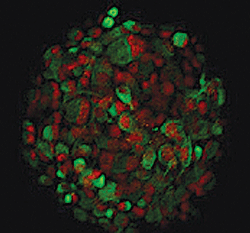Corneal cells could be adapted for use in the retina to treat blinding eye conditions, according to a recent study in the British Journal of Ophthalmology.

Stem cells isolated from the corneal limbus grow in culture. Photo: University of Southampton
Using a mouse model, researchers in England discovered that corneal limbal stromal progenitor cells could be cultured to create functional neuronal retinal cells that could be used in the very same patient.
“We are now investigating whether these cells could be taken from the front of the eye and be used to replace diseased cells in the back of the eye in the retina,” says lead author Andrew Lotery, M.D., FRCOphth, a professor of ophthalmology at the University of Southampton, U.K. “If successful, this would open up new and efficient ways of treating people who have blinding eye conditions.”
Specifically, it could mean new treatments for conditions such as retinitis pigmentosa and wet AMD. By using corneal limbal stromal cells, patients would avoid complications with rejection or contamination because the cells taken from the eye would be returned back to the same patient, the authors contend.
The corneal limbus is one of the most accessible regions of the eye, which means cells could be easily obtained with little risk to the patient’s eyes and vision.
While the discovery is promising, Dr. Lotery says more research is needed to develop the approach before it can be used in human patients.
Chen X, Thomson H, Hossain P, Lotery A. Characterisation of mouse limbal neurosphere cells: a potential cell source of functional neurons. B J Ophthalmol. 2012 Nov;96(11):1431-7.











